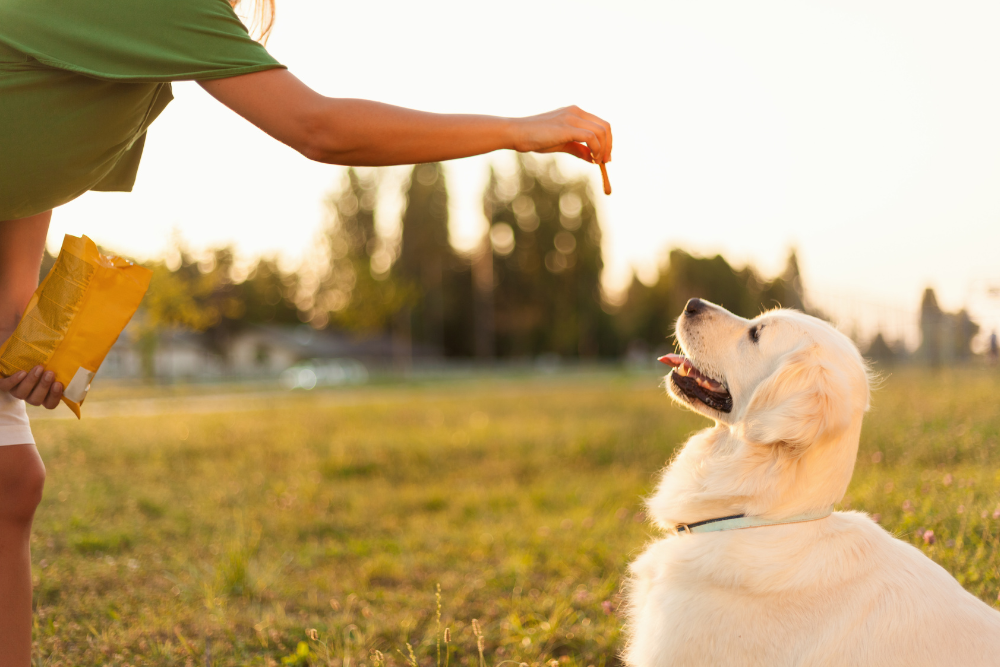From Bribes to Behavior: Teaching Dogs to Work Without Visible Rewards
You've put in the time. You've taught your dog how to sit, down, stay, come when called—maybe even a few fun tricks. At home, everything looks great. Your dog responds eagerly, watches you closely, and seems to love training time. But the moment you step outside or walk into a more distracting space, things start to fall apart. Suddenly, you're back to waving food in front of their face, digging for a cookie, or repeating cues as your dog's focus drifts.
If this sounds familiar, you're not alone. And no, your dog isn't being stubborn. They're simply not yet equipped to handle the real world.
Bribery vs. Reinforcement
Let's talk about the difference between a bribe and a reinforcer. A bribe happens before the behavior—your dog sees the cookie and decides to comply. A reinforcer comes after the behavior—it rewards a choice your dog made. The problem with relying on bribes is that it creates dependency. If your dog learns to only respond when they see the cookie, then you'll always need to show the cookie.
That's not sustainable, and it's not the kind of training most of us want in the long run.
Instead, the goal is to teach your dog that engagement and good behavior always lead to reinforcement—even when they don't see it right away. That shift builds reliability, resilience, and confidence in all kinds of environments.
The Challenge of Distractions
Distractions aren't just "extra hard stuff." They're actually part of the learning process. Dogs don't naturally generalize behaviors across different locations or contexts. Just because your dog can sit in your living room doesn't mean they'll do it at the vet's office or when a jogger goes by.
Each new place or distraction adds an invisible question: Does the cue still matter here? Unless you've helped your dog answer that question, you may not get the behavior you're expecting.
This is why dogs seem to "forget" their training in public or in new environments. They haven't forgotten—they just haven't learned how to apply those skills under pressure or amidst exciting things.
Strategic Use of Reinforcement
So how do we fix it? We shift how we use reinforcement.
Rather than relying on visible food or toys, we begin by teaching the dog that reinforcement is coming, even if it's not in our hand. That might mean delivering the treat from your pocket, from a dish behind you, or even tossing it on the ground after a successful rep. The key is teaching your dog to perform first and trust that reinforcement will follow.
Next, we start training in gradually more distracting environments. Maybe that means moving from your kitchen to your backyard, then to the front yard, then to a quiet park, and so on. Each time, you're helping your dog make the right choices in more challenging situations—building not just obedience, but real-life reliability.
You can also layer in controlled distractions during training. That might mean a toy on the ground, another person nearby, or a food bowl off to the side. When done thoughtfully, this helps your dog learn to ignore the distraction and focus on the task, rather than being overwhelmed or confused.
Reliability Takes Practice
There's no magic formula for getting a dog to respond in every environment—but there is a systematic process. It involves gradually increasing difficulty, managing distractions, using reinforcement strategically, and giving your dog plenty of chances to succeed.
If you're still carrying cookies in your pocket everywhere you go, don't worry. You're not doing anything wrong—you're simply at an earlier stage in the process. The goal is to move from management and bribery to strong, reliable behavior that holds up anywhere. With a thoughtful plan and consistent training, you'll get there—and your dog will be happier and more confident for it.
By accepting you will be accessing a service provided by a third-party external to https://www.fenzidogsportsacademy.com/
